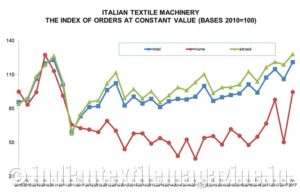The orders index for textile machinery compiled by ACIMIT, the Association of Italian Textile Machinery Manufacturers, rose by 29% for the period October – December 2017 compared to the same period the previous year. The index value stood at 120.9 points (basis: 100 in 2010).

This growth rate affected both the foreign markets, for which the index registered an absolute value of 128 points (+23%), and the domestic market in Italy. In the latter case, the increase was 72% compared to the period October – December 2016, for absolute value of 94.5 points.
On an annual basis, the index registered an average increase of 18% with respect to 2016. Domestic orders were up 36%, a significant rise that goes to confirm the effectiveness of the Government measures to support investments by Italian manufacturers. Foreign markets also registered a substantial increase in orders for the entire year (+16%).
ACIMIT President Alessandro Zucchi commented on these results as follows: “The orders index for 2017 confirms that our sector is in good health, with a production trend that has been growing since 2015.”
Based on updated data for the first nine months of 2017, Italian exports increased 10% compared to the period from January to September 2016, with solid performances by Italian businesses in the industry in all major markets. In Italy, the measures envisaged in the National Industrial Plan 4.0 were responsible for launching purchases of advanced machinery.”
Zucchi further stated: “The textile sector is currently constrained, more than ever before, to attentively look into the applications offered by Industry 4.0. Demand in the industry is evolving continuously, and the concept of time-to-market is taken to extremes, so that the required production processes must be just as fast and inter-connected to meet the demands of end consumers. Nonetheless, it would have been difficult to imagine such a significant leverage effect from the 4.0 incentives.”
